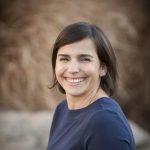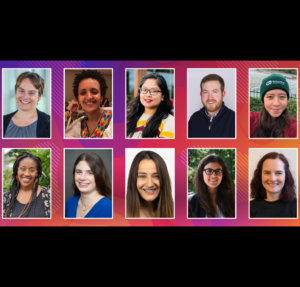Guest post by Tânia Reis, Chair of GSA’s Conference Childcare Committee, on barriers to conference participation and how we can address them.
I’m a Scientist. I’m a Mom. I couldn’t pick one over the other; half of me would be missing. I am lucky I have never had to choose. Yet, there were and are times that these two roles seemed incompatible.
But why should it be this way? Despite the challenges, being a scientist has made me a better mom, and being a mom has made me a better scientist. Why the barriers? Why the lack of support? These are questions many of us have when we are “in the trenches.” And being in the trenches has made me think a lot about the many little things that could easily be changed to make a huge difference to the mom and dad scientists.
My husband is a dad. And a scientist, a dad scientist, and a scientist dad. His “barriers” have been very different from mine. At our institutions, we are very used to juggling our kids and our science, planning who can drop everything for the sick kid that day, who goes on the field trip, who has a meeting or an assay that day. For the most part, we handle it, not as gracefully as we imagined before parenting, but in a way that balls don’t get dropped (at least not the major ones…a minor ball may bounce away now and then, and we’re learning to live with it).
Our kids are veterans at scientific meetings. Both have breastfed, melted down, and played hide-and-seek in the hallways of the different hotels and universities of GSA conferences. (When you next see me, ask me about that time that we ended up in the San Diego Children’s ER just as the fly meeting started! The joys!!). We have had institutional retreats where we both present and the kids come along. They know the drill. They even enjoy listening to talks from time to time.
Yet, one of our biggest challenges was TAGC 2016: we always attend the GSA fly (me) and yeast (him) meetings, and we were excited to attend this one, too. We were actually one of the 28 parent attendees to be awarded a GSA childcare grant. We used ours to fly our three and seven-year old kids with us to the meeting; without nearby family who could drop everything, we had no choice. I had a workshop to host and a poster to present, some lunches to sit in; husband had a talk to give. We juggled it all again, as we know so well how to do. But, this time around we both thought that we missed too much. We took too little out of this meeting, and we wanted to take so much more. With TAGC 2020 just around the corner, we want to ask: how could the experience of parents with young children be different?
Our experience and variations are far from unique. Scientists everywhere end up missing meetings because of lack of childcare support. And it’s not just them missing out— the whole community misses out when parents can’t fully participate.
Because GSA wants to help address this problem, it has formed a Conference Childcare Committee. I think my years of “nagging” for something to improve has earned me the committee Chair position. Like me, many others reached out.
This is who we are, and we are pumped!
- Julie Claycomb, Associate Professor, University of Toronto
- Sean Curran, Associate Professor, University of Southern California
- Rhea Datta, Assistant Professor, Hamilton College
- Madhumala Sadanandappa, Postdoc, Dartmouth College
- Elisabeth Marnik, Postdoc, MDI Biological Laboratory
- Thomas Merritt, Professor, Laurentian University
- Maureen Peters, Associate Professor, Oberlin College
- Maria D. Vibranovski, Assistant Professor, University of São Paulo
- Gillian Stanfield, Associate Professor, University of Utah
As you can see, the Drosophila and C. elegans communities are well represented. Because every GSA meeting looks and operates differently, we’d love to have members of other communities, too. Are you also interested in making conferences more inclusive, and don’t see your community represented? Send us an email!
After our first couple of meetings, it was obvious that, like me, many others have been thinking over the years “How can we make this better for parents and caregivers? Accessible for everyone? So everyone can contribute their science to the community?”
We have so many ideas.
We are building a growing list of “first steps” (relatively easy-to-implement ideas, some of which build on existing GSA initiatives) and “big goals” (harder, either practically or financially, to implement) for parents and caregivers. We are also working on messaging, and we’re researching opportunities for funding, from grants to requesting supplements from vendors. If you know of an organization looking to fund meaningful projects for improving science, let us know!
Here are some ideas from the (ever-growing) list:
First steps:
- Data collection at registration: better understand how many attendees are bringing children, how many need nursing facilities, etc; including an option for connecting with other parents attending.
- Better informing parents: adding inclusive messaging to the website and providing more detailed information on resources available. Making sure parents know that they and their children are welcome.
- Family Room at the conference: Provide a Family Room that includes games for kids and session broadcasts for parents.
- Connecting parents at GSA conferences: Set up a Slack channel or other forum for parents and caregivers to connect at the meeting.
- Nursing Room standards: Ensure Nursing Room is easily accessible and equipped with a fridge, sink, microwave, and private pumping areas.
- Exhibitor support: Offer exhibitors the opportunity to donate to the childcare funds and to equip the Family Room.
- Conference session: Develop a work/family life session or workshop for current and future parents or caregivers.
- Kids Session: Fun outreach opportunity for kids to present their parents’ work or other passion area in science.
Big goals:
- Provide onsite childcare: Although costs make this a major challenge, particularly for GSA’s smaller community meetings, it would be a game changer for parent attendees.
- Expanding the Childcare Grants: These need-based grants can be given to provide care either at the meeting or at home; the more funding we can find, the more we can offer. We would like to support more people and provide more support per grantee.
We are working with the GSA Board of Directors on setting priorities and finding funding to see as much as possible in effect for TAGC 2020.
We have so far only looked at things we personally missed and guessed at those things we think others may be missing. Because we’re sure others have additional ideas (or support for existing ones), we’d like to ask the community what they think. What would help you and your family? What do you have to add?
Contact me at tania.reis@cuanschutz.edu.
About the author:

Tânia Reis
Tânia Reis is an Associate Professor at the University of Colorado Anschutz Medical Campus, mom of a 9-year old boy and a 5-year old girl, and chair of GSA’s Conference Childcare Committee.













